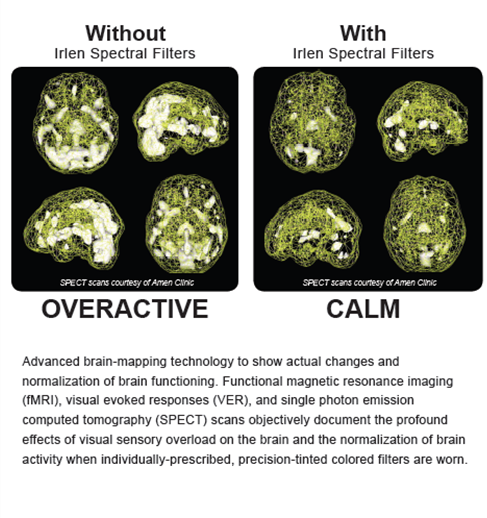SUMMARY OF RESEARCH
The Irlen Method and the efficacy of colored overlays and colored filters has been the subject of over 200 research studies in education, psychology, and medicine. This research has established a hereditary component of the disorder1-2, a number of biochemical markers for problems associated with Irlen Syndrome3, and differences between both the anatomy and functioning of brains of individuals with Irlen Syndrome4-7. The research has repeatedly documented improvements in a variety of reading skills, reduction in physical symptoms, and improved functioning and success in both academia and the workplace8-13. Research on Irlen Syndrome has also documented co-morbidity with a variety of other disorders, including chronic fatigue syndrome14, ADHD15, and autism16. A review of 62 studies published in peer-reviewed journals found 56 studies with positive findings, 45 with positive results for particular reading skills, and 11 showing improvements in accommodation facility, eye movements while reading, and reduced headaches/migraine. FOR MORE RESEARCH
PEER-REVIEWED JOURNALS
Studies on Irlen Syndrome have been published in numerous peer-reviewed journals worldwide. These include the Australian Journal of Learning Disabilities, Australian Journal of Special Education, Behavioral Optometry, Brain Topography, Journal of Clinical & Experimental Neuropsychology, Journal of Learning Disabilities, Journal of Research in Reading, Korean Journal of Ophthalmology, Ophthalmological and Physiological Optics, Perceptual and Motor Skills, among others.
RECOGNIZED AS A STANDARD ACCOMMODATION AND ASSISTIVE TECHNOLOGY
Irlen Colored Overlays and Irlen Spectral Filters are used by millions of children and adults in more than 45 countries around the world. Colored overlays and/or colored filters are recognized as a standard accommodation for standardized testing in many states in America, including California, Arkansas, Florida, Oklahoma, Nevada, Massachusetts, New Mexico, and Washington. The SAT, LSAT, ACT, Recording for the Blind, Illinois Department of Rehabilitation, Indiana Office of Vocational Rehabilitation, Michigan Rehabilitation Services, Texas Commission for the Blind, Nevada Vocational Rehabilitation Services, and Wisconsin Vocational Rehabilitation all officially recognize Irlen Syndrome. In Australia, the following are a sampling of agencies which have officially recognized Irlen Syndrome: Department of Employment, Education & Training, Departments of Army, Navy, and Air Force, Board of Studies – NSW, Board of Secondary Education – WA, Department of Children’s Services – WA, Commonwealth Employment Service (CES), Department of Rehabilitation, Geelong Medical Fund, and Technical and Further Education (TAFE).
UNITED STATES NAVY HAS REPEATEDLY SUBSTANTIATED THE EXISTENCE OF IRLEN SYNDROME
Naval Aerospace Medical Research Laboratory (NAMRL) documented the presence of Irlen syndrome in Navy recruits and the success of Irlen color intervention to improve reading skills.
Ekenna-Kalu, C., Fatolitis, P., Momen, N., Haseltine, C., Temme, L., Krouse., S. (2006). Meares-Irlen Syndrome Innovation Study: Assessment of the potential for colored overlays to enhance the reading skills of listed recruits (Navy). Report by the Naval Aerospace Medical Research Laboratory (NAMRL), July, 2006.
Varied the energy spectrum presented to the eye, which resulted in varying reading speeds and concluded that the Irlen effect is real.
Irvine, J.H., & Irvine, E.W. (1997). Scotopic Sensitivity Syndrome in a single individual (a case study). Report by the Naval Air Warfare Center, Weapons Division, China Lake, CA, April 1997.
References
- Loew, S.J., & Watson, K. (2012). A prospective genetic marker of the visual perception disorder Meares–Irlen syndrome. Perceptual and Motor Skills, 114(3), 870-882.
- Robinson, G.L., Foreman, P.J., Dear, K.G.B., and Sparkes, D. (2004). The Family Incidence of a Visual-Perceptual Subtype of Dyslexia. Nova Science Publishers, 27-40.
- Robinson, G.L., Roberts, T.K., McGregor, N.R., Dunstan, R.H., & Butt, H. (1999). Understanding the causal mechanisms of visual processing problems: a possible biochemical basis for Irlen Syndrome? Australian Journal of Learning Disabilities, 4(4), 21-29.
- Chouinard, B.D., Zhou, C.l., Hrybousky, S., Kim, E.S., Cummine, J. (2012). A functional neuroimaging case study of Meares-Irlen syndrome/visual stress (MISViS). Brain Topography, 25(3):293-307.
- Huang, J., Zong, X., Wilkins, A., Jenkins, B., Bozoki, A., Cao, Y. (2011). fMRI evidence that precision opthalmic tints reduce cortical hyperactivation in migraine. Cephalagia, 31(8):925-36.
- Lewine, J.D., Davis, J., Provencal, S., Edgar, J., Orrison, W. (1997). A magnetoencephalographic investigation of visual information processing in Irlen’s Scotopic Sensitivity Syndrome. Conducted at The Center for Advanced Medical Technologies, The University of Utah School of Medicine, Salt Lake City, Utah, and Department of Psychology, The University of New Mexico, Albuquerque, New Mexico.
- Yellen, A. & Schweller, T. (2009). The Yellen-Schweller Effect: Visual Evoked Responses and Irlen Syndrome.
- Noble, J., Orton, M., Irlen, S., Robinson, G. (2004). A controlled field study of the use of colored overlays on reading achievement. Australian Journal of Learning Disabilities, 9, 14-22.
- Park, S.H., Kim, S., Cho, Y.A., Joo, C. (2012). The Effect of Colored Filters in Patients with Meares-Irlen Syndrome. J Korean Ophthalmol Soc., 53(3):452-459. Korean. Published online 2012 March 15. https://dx.doi.org/10.3341/jkos.2012.53.3.452
- Robinson, G.L., & Foreman, P.J. (1999). Scotopic sensitivity/Irlen syndrome and the use of colored filters: A long-term placebo controlled study of reading strategies using analysis of miscue. Perceptual & Motor Skills, 88, 35-52.
- Irlen, H., & Robinson, G.L. (1996). The effect of Irlen coloured filters on adult perception of workplace performance: a preliminary survey. Australian Journal of Remedial Education, 1, 7-17.
- Robinson, G.L., & Conway, R.N.F. (2000). Irlen lenses and adults: a small scale study of reading speed, accuracy, comprehension and self-image. Australian Journal of Learning Disabilities, 5, 4-13.
- Whiting, P., Robinson, G.L., & Parrot, C.F. (1994). Irlen colored filters for reading: a six year follow up. Australian Journal of Remedial Education, 26, 13-19.
- Loew, S.J., Marsh, N.V. & Watson, K (2014). Symptoms of Meares-Irlen/Visual Stress Syndrome in subjects diagnosed with Chronic Fatigue Syndrome. International Journal of Clinical and Health Psychology, 14(2), 87-92.
- Loew, S.J. & Watson, K. (2013). The prevalence of symptoms of scotopic sensitivity/Meares-Irlen syndrome in subjects diagnosed with ADHD: Does misdiagnosis play a significant role? Croatian Review of Rehabilitation Research, Vol.49. Supplement, str. 50-58.
- Irlen, H. (2012). A sensory intervention for visual processing deficits using precision colored filters. Autism Science Digest: The Journal of AutismOne, 04, 94-102.


